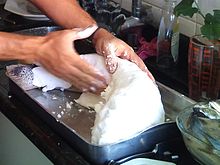
A salt crust is a method of cooking by completely covering an ingredient such as fish, chicken or vegetables in salt (sometimes bound together by water or egg white) before baking. The salt layer acts as insulation and helps cook the food in an even and gentle manner. After baking, the salt crust is cracked and discarded, revealing the moist and evenly cooked food.[1][2]
Technique and foods[edit]

Typically delicate foods such as fish, chicken/poultry or vegetables are cooked using this method. In each case the aim is to lock in moisture, protect the food from drying, ensure even cooking, and maximise the flavour.[3]
The salt crust can be created simply by adding a sufficient quantity of coarse or fine salt to cover the food item. Water may be sprayed on top, to help the salt form a hard crust. Alternatively, the salt may be mixed with egg white to form a pliable paste.[4]
Baking typically occurs in an oven at around 200 °C (390 °F), with the salt crust acting as a cooking vessel. This slows heat transfer to the food creating a slow and low dry oven, beneficial to most proteins.[5]
To serve, the crust is broken and carefully removed, to avoid leaving excess salt residues in the food.
Steak can also be cooked using a similar method rather than broiling it and risk the loss of its juices. Coating a pan with salt and cooking the steak, ideally approximately an inch thick or less, on top yields a more moist and flavourful cut. The pan is heated until the salt crackles and steaks cooked with this method usually involves a crispy crust made of the salt. This is a key difference to other salt crusts as usually it is discarded but in this case it is used to add texture and flavour to the steak.[6]
History[edit]
The earliest recipe found for salt-baked is from the fourth century BCE in Archestratus' Life of Luxury. The recipe details for a whole, round white fish such as sea bass, snapper or sea bream that was cleaned and then gutted. The fish is seasoned with thyme being inserted into the cavity of the fish prior to the salt crust encapsulating it in two pounds of salt glued together with water and egg whites.[7]
In a Muslim cookbook originating from the thirteenth century, a layer of salt is placed on a new terracotta tile as a base and the fish is placed on top and another layer of salt is added on, then finally being placed in an oven.
The first recorded reference in China resembling the technique of baking in a salt crust is salt-baked chicken from Dong Jing in the province of Guangdong during the Qing Dynasty (1644–1911). The chicken was cooked and preserved in the salt fields of the area giving them added flavour. A more recent traditionally recipe is building a cocoon of salt around the chicken protecting it from direct heat ensuring even cooking and the possibility of drying out the meat. The chicken is wrapped in a tight parcel concentrating all the natural flavours of the chicken resulting in a succulent and tender product. This can be seen as the combination of the salt crust method with the French en papillote style.[8]
Around the world[edit]
- The salt-crusted fish has appeared in many different countries such as France, Italy, Spain and China.[9][7]
- In southern Italy, fish native to the region such as bass, bream trout or snapper is traditionally baked in salt crust, using a combination of coarse salt for the base and fine salt for the top layer.[10]
- In Thailand, salt crusted fish is cooked, stuffed with lemongrass.[11]
- In Turkey, chicken baked in salt crust is a traditional dish from the province of Hatay, with records dating back to the Ottoman period. It is believed[by whom?] that the technique may have been adopted from China.[citation needed]
- In Colombia, beef tenderloin is baked in a salt crust, then wrapped in a kitchen towel and baked on a top of hot coals.[12]
Bibliography[edit]
- Ahrné, Lilia; Andersson, Claes-Göran; Floberg, Per; Rosén, Johan; Lingnert, Hans (December 2007). "Effect of crust temperature and water content on acrylamide formation during baking of white bread: Steam and falling temperature baking". LWT - Food Science and Technology. 40 (10): 1708–1715. doi:10.1016/j.lwt.2007.01.010.
- Martin James (2007) "Salt-crusted Sea Bass with runner bean salad"
- Dimbleby H., and Baxter J. (2015) "A Sicilian feast with salt-crusted seabass". The Guardian.
See also[edit]
- acrylamide – Organic chemical compound
References[edit]
- ^ Mitarai, Kumiko (April 12, 2010). "How to Bake in a Salt Crust". www.seriouseats.com. Retrieved 2018-10-20.
- ^ "Salt-baking vegetables: Is it worth it?". Washington Post. Retrieved 2018-11-09.
- ^ "Chicken baked in a salt crust". Food. Retrieved 2018-11-09.
- ^ "Video Recipe: Salt-Crusted Fish - Video Recipe - FineCooking". FineCooking. Retrieved 2018-10-20.
- ^ McGee, Harold; McInerney, Jack; Harrus, Alain (1999). "The Virtual Cook: Modeling Heat Transfer in the Kitchen". Physics Today. 52 (11): 30–36. Bibcode:1999PhT....52k..30M. doi:10.1063/1.882728. ISSN 0031-9228.
- ^ Miller, Bryan. "Getting The Most Out Of Meat By Cooking In Salt Bed Or Pastry". Retrieved 2018-11-09.
- ^ a b "Culinary History Mysteries #1: Salt-Baked Fish – Silk Road Gourmet". www.silkroadgourmet.com. Retrieved 2018-10-20.
- ^ "Salt Baked Chicken recipe (盐焗鸡) - The step-by-step guide". Taste Of Asian Food. 2018-08-07. Retrieved 2018-11-09.
- ^ Kaba, N (2015). "A traditional food: 'fish baked in a salt crust'" (PDF). International Food Research Journal. 22 (2): 866–868 – via University of Sinop.
- ^ "Fish in a Salt Crust, Local Recipe in Sicily, Italy". www.summerinitaly.com. Retrieved 2018-11-09.
- ^ "Discover the amazing story of salt and its importance in Thai culinary culture - TAT Newsroom". TAT Newsroom. 2016-04-26. Retrieved 2018-10-20.
- ^ John, Chef (2016-12-09). "Salt-Crusted Beef Tenderloin – No Lomo". Food Wishes Video Recipes. Retrieved 2018-11-09.